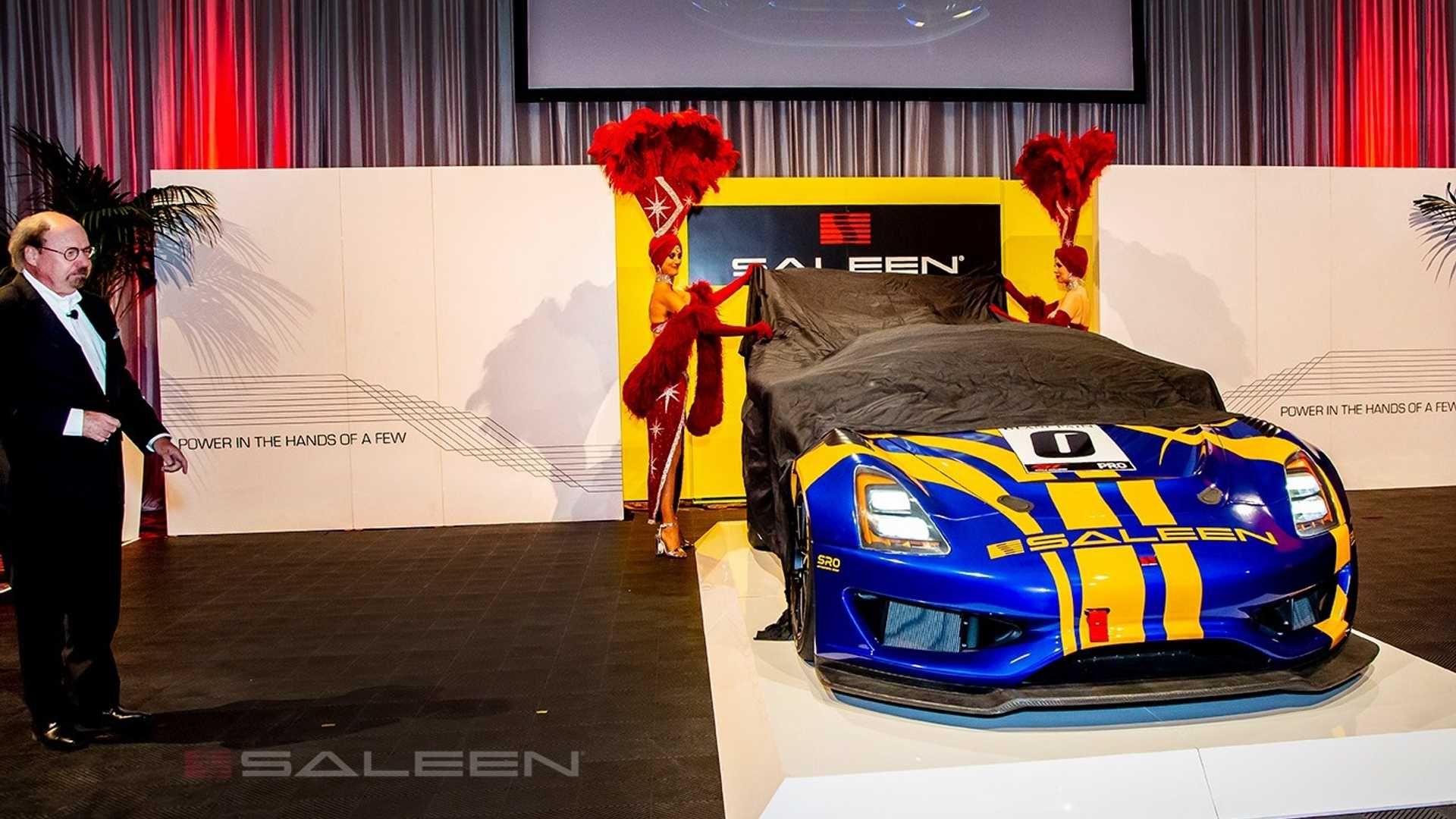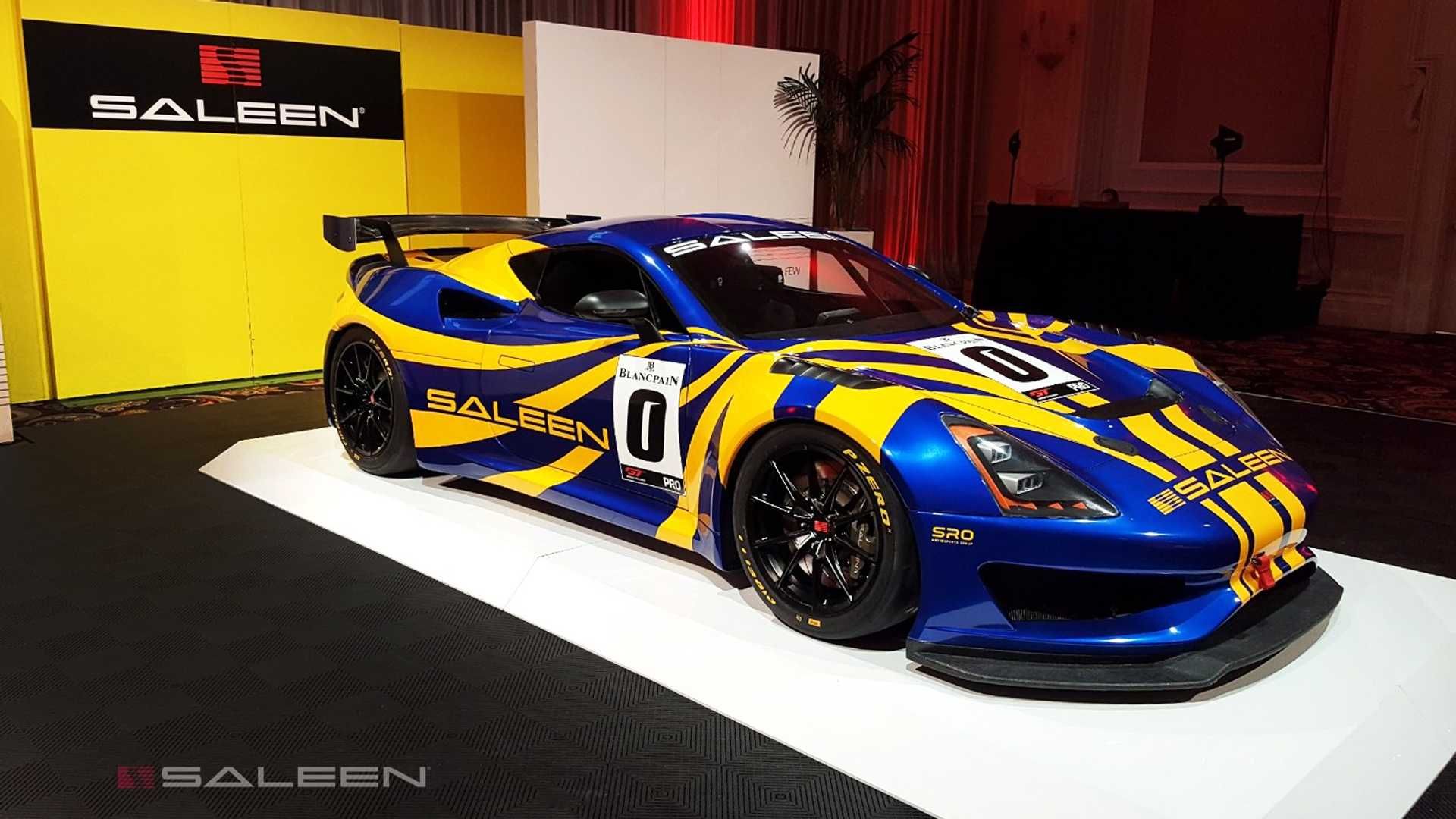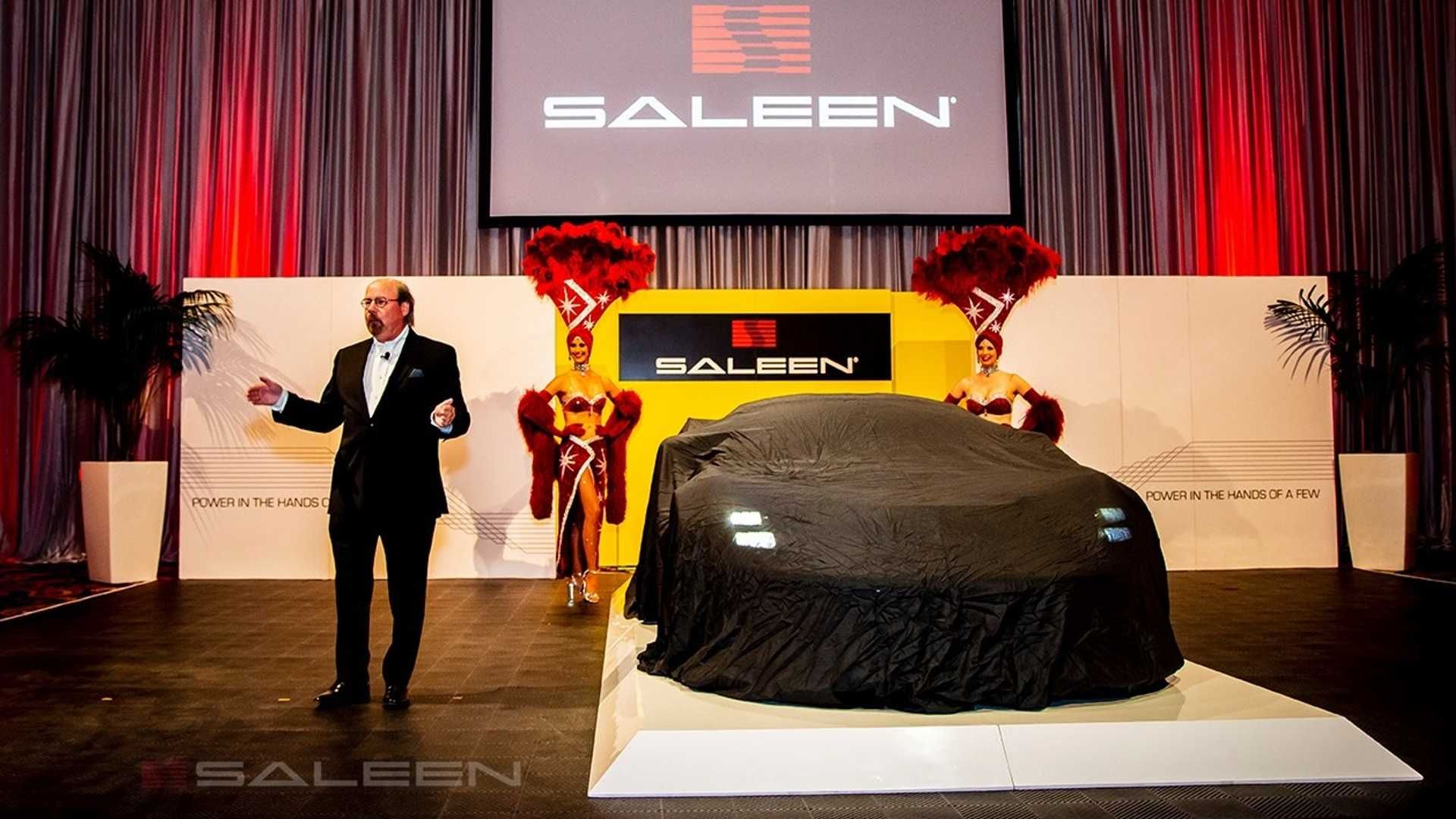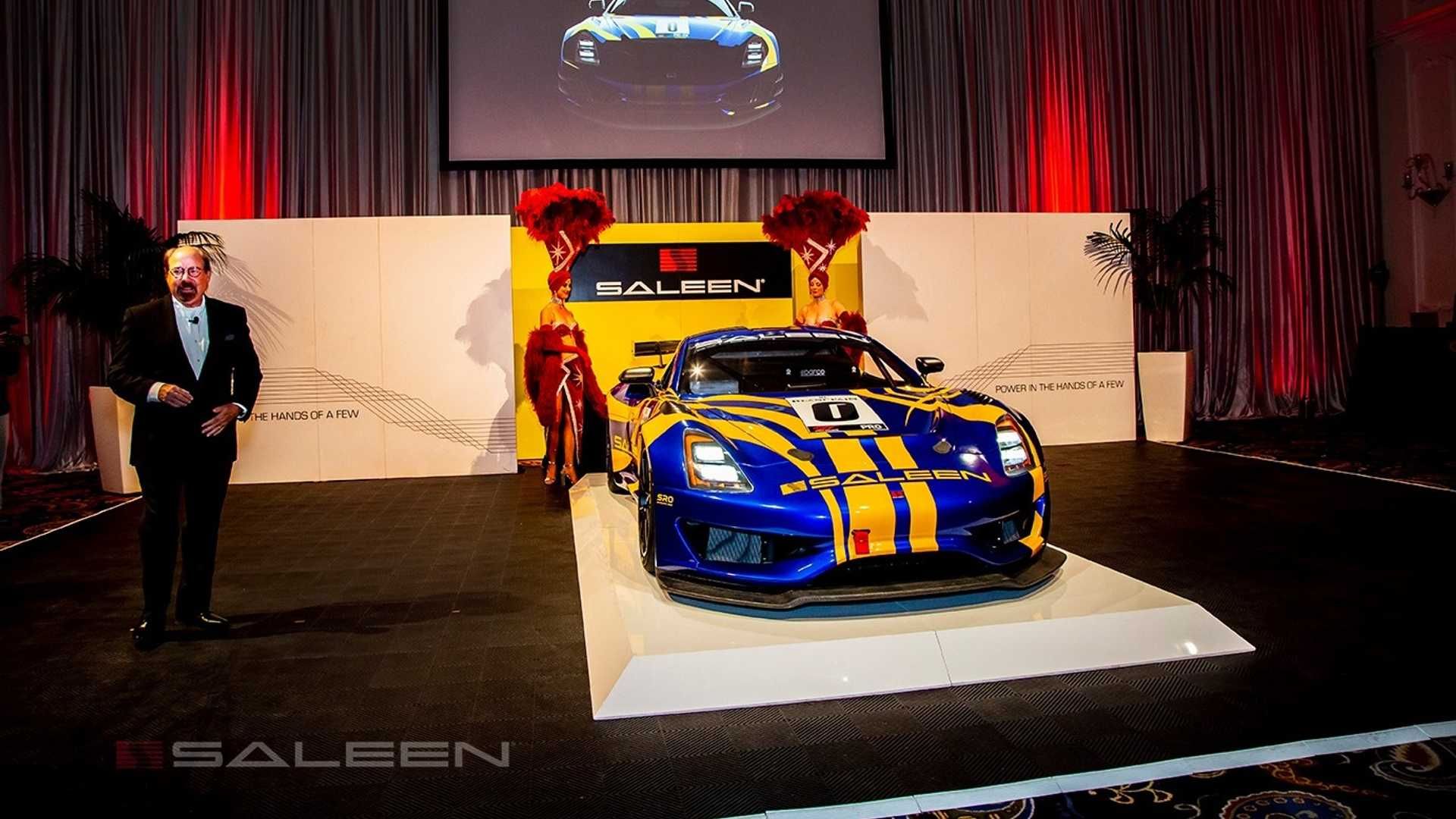Saleen unveiled last weekend in Las Vegas the concept version of its upcoming GT4 racer based on the Saleen One mid-engined supercar. The American manufacturer, known for making the ludicrous S7 for years, plans to have a few cars on the grid in the 2020 season of the Pirelli GT4 America championship. With 450 horsepower from a turbocharged 2.2-liter four-pot, the car is priced at $225,000.
Saleen is back in the game after entirely too many years away. It's been a full decade since the twin-turbocharged version of the S7 hypercar retired from active competition. Since then, S7 examples have been seen huffing and puffing during historic racing meetings but the company that made them laid dormant until about 12 months ago when it announced a full-blown single-make series revolving its new product, known at the time as the Saleen S1. Plans for a GT4-spec car were outlined at the time and, following the success of the single-make series, Saleen now follows up on its promises and has unveiled the GT4 racer that will take on the best from Porsche, McLaren, Audi, BMW, Mercedes-AMG, Chevrolet, and many others.
2020 Saleen GT4 Concept Race Car
- Make: Array
- Model: 2020 Saleen GT4 Concept Race Car
- [do not use] Vehicle Model: Array
History of Saleen
Saleen is a long-standing tuner and maker of one of the fastest American cars of modern times. Starting out as a company offering comprehensive tuning kits for the fox body Mustang in the '80s, Saleen grew to become an automaker and entrant in the world's most important racing events such as the 24 Hours of Le Mans while still inexorably linked to Ford Motor Company. To this day, Saleen puts out souped-up Mustangs but, since 2017, its focus has been on the Saleen One, a Porsche 911 rival that features a mid-engine layout and continues the tradition of Saleen engines being powered by a unit developed in-house, not one borrowed from the Blue Oval.
The first modified Mustang arrived in 1984 but only three prototypes were built that year before a whole production run kicked off in '85. Using knowledge gained throughout his career, Saleen set about improving the Mustang's handling first and foremost. His efforts were quickly put to the test in the arena of racing as Saleen entered the 1986 SCCA ESCORT Endurance Championship for showroom-stock sedans and sports cars. The early Saleen products featured upgraded brakes, suspension, Koni adjustable shock absorbers, and a series of visual modifications such as the addition of a spoiler on the decklid in the back and an air dam in the front. Bigger wheels with grippier tires were part of the serving too and the whole package proved competitive right off the bat. In one of the most grueling events of the '86 season, the 24 Hours of Mosport, in Canada, a Saleen-prepped Mustang won ahead of a host of other Mustangs, Pontiacs, British Triumph models, and even Corvettes. Steve Saleen himself was part of the driving roaster of the winning car along with ex-F1 driver Desiree Wilson and IMSA stalwart Skeeter McKitterick.
While the Saleen Mustangs boasted a race-proven record, the company wasn't particularly high profile although it offered a 480 horsepower Mustang in the 1994 Saleen Mustang SR based on the SN95 generation. Publicity finally arrived in droves the following year when Hollywood star Tim Allen partnered Saleen to form the Saleen/Allen “RRR” Speedlab race team. Featuring a by-now classic livery with the 'Blazing Horse' on the sides of the cars painted in a combination of yellow, black, and white, the Mustangs swept the manufacturer's championship in the Speed World Challenge GT series. That same year, Saleen was inducted into the Mustang Hall of Fame
1997 was an even bigger year for Saleen as it finally debuted a car ready to take on the world: the Saleen Mustang GT2 that would compete in the IMSA GT Championship, the FIA GT Championship, and, most importantly, the 24 Hours of Le Mans. Debuting in that year's 24 Hours of Daytona, the Mustang didn't cause much of a stir as it proved slow (six seconds off the pace in qualifying) and unreliable, both cars entered finishing towards the very back of the pack. Things improved by the time the pair of Works-backed cars arrived at Sebring and one of them finished 20th overall (fifth in class). After that, both cars managed to set good enough times during the Le Mans Test Day in May to qualify for the French endurance classic.
In the years that followed, the S7R won numerous races in the ALMS, the FIA GT, and Grand-Am, but it rarely managed to connect all the dots and deliver a successful championship-winning campaign despite the fact that a number of top-level teams raced S7Rs. Vitaphone Racing did, for instance, in 2004 before switching to the all-conquering Maserati MC12 the following year. The French outfit ORECA that would go on to build sports cars under its own name also raced Saleens as did ACEMCO Motorsport (who also built their own chassis), Zakspeed Motorsport, or RML, the primary builder of S7R chassis.
Exterior
Since the S7R retired from competition in 2009, the Saleen name has not been seen in top-level competition. All that changed in 2019 when Saleen officially returned to the tracks with a race-prepped version of its upcoming affordable supercar, the One. Announced as far back as October 2018, the single-make series was greeted with skepticism as most expected it not to materialize, much like the company's plans to launch a replacement for the S7 that date as far back as 2008 when the S5S Raptor concept car was shown to the public only to be followed by a series of unfulfilled promises.
When the plans for a single-make series were laid out, Saleen's Gabriele Cadringher who took over as Head of Motorsports after a long sting as FIA Technical Director, said that the Cup model is "a pre-series of the GT4 .” He also said at the time that "my plan is to come on the market with the GT4 car much cheaper than anyone else. I want to sell this car for $160-170,000, ready to be raced.”
In March, the championship was officially launched as a support series for the GT World Challenge America Championship starting with the Californian round at Sonoma Raceway in June. Each racing weekend featured a pair of 50-minute races with a mandatory pit stop to be done during a pre-determined pit stop window in each of the two races. Saleen said the cost for the full 10-race season would be under $200,000 for those that entered before the end of March.
The GT4 concept car was presented last weekend at a hotel in Las Vegas at the same time as the GT World Challenge America season finale. It is, as tipped by Cadringher, the test mule for the Cup car that's been updated to GT4 specification after all of the testing was completed to establish the final performance levels/spec for the Cup model. The transformation of one chassis from one specification to another proves how closely related the two models are. Broadly speaking, the GT4 version features a slightly more aggressive aerodynamic package with a bigger wing, bigger diffuser, and more aggressive splitter, as well as a bigger fuel tank in the view of potential endurance racing that the car could do next year.
The headlights are located above each of the two elongated inlets and are shaped somewhat like a plane's vertical stabilizer. A pair of latches hold the front lid in place. There's also a towing loop attached to the front bumper. The front lid sports a rear-facing opening for the air that entered through the opening in the middle of the nose to get out. There are also louvered openings on the top of the front fenders.
Viewed from the side, the One GT4 seats low and mean with a double-bubbled roof (and maybe a roof scoop on the final version as seen in the renderings). The car rides on 10-spoke 18-inch alloy wheels hugged by Pirelli P-Zero Corsa rubber, standard in the GT World Challenge America Championship. The exterior rear-view mirrors are mounted on the doors and are made out of carbon fiber. Aft of the doors, vents open on either side of the car on top of the rear fenders. The engine lid in the back features a see-through glass like on Italy's best-well-known supercars.
What's not similar is the GT4 model's big diffuser with no less than six vertical elements. There are two vents placed outboard on either side as well as an opening in the middle where you'll find the exhaust tips. Overall, the Saleen One GT4 is a good looking sports car that will compound the GT4 World Challenge America grid and diversify the American offering of GT4 racers, adding to the existing Camaro GT4.R, the Mustang GT4, and the Panoz Avezzano GT4.
Interior
The Saleen One GT4, just like any other serious racing car, packs only the essentials inside in a bid to save as much weight as possible. While the cabin of the road-going One is covered in two-tone leather and features a Tesla-like touch-screen display on the center console, the racing car is a lot less luxurious.
Given this is a customer car, most of the controls are adjustable including the steering column, pedal box, and seat. This doesn't mean, however, that a taller fellow won't have some issues getting in past the myriad of bars that make up the roll-cage but it's all in the effort of keeping everybody safe. An in-cabin fire suppression system will also probably be part of the deal.
Drivetrain
Much of the components of the GT4 car will be shared with the Cup model. The monocoque chassis, made out of a blend of aluminum and carbon fiber, is the same and carbon fiber is also used for the body panels.
That engine is the same 2.2-liter, turbocharged inline-four designed and built in-house by Saleen at its headquarters in Corona, California. The engine puts out about 100 horsepower less than what a GT3 model brings to the table while the GT3 car also features a more aggressive aerodynamics package. Saleen too may move up to GT3-level competition in the future but, seemingly, it won't be with the Saleen One but with a different, still yet to be announced model that could fill the gap created by the disappearance of the S7.
Suspension is by double arms on all four corners with adjustable dampers. On the Cup model, brakes are by TM Performance. In the front, you'll find 14.96-inch rotors with six-piston calipers and in the back, there are 13.97-inch rotors with four-piston calipers. The GT4 car may feature a similar arrangement but with ABS all around as mandated by the class rules. Traction control is also mandatory and the steering is assisted.
Saleen's Gabriele Cadringher told the press that "we found during the inaugural Saleen Cup season, our test session lap times were already competitive with the top GT4 times, regardless of the track." So, apparently, performance isn't an issue for the One but reliability could be as a number of cars were seen falling by the wayside during every weekend of the Saleen Cup.
However, we hope that these issues will be ironed out by the time Saleen commences in November to build the first batch of 14 GT4-spec cars that will be sold for $225,000 each. Saleen plans to enter a pair of cars in the 2020 GT4 World Challenge America Championship in the Pro-Am category for its champion drivers in the Saleen Cup.
2019 Saleen GT4 Concept Race Car specifications
|
Engine |
2.2-liter, turbocharged inline-four |
|---|---|
|
Output |
450 horsepower |
|
Suspension |
independent, adjustable with double arms all around |
|
Steering |
rack-and-pinion assisted |
|
Gearbox |
Semi-automatic with flappy paddles behind the wheel |
|
Brakes |
TM Performance racing brakes, six-piston calipers in the front and four-piston calipers in the rear |
|
Top speed |
about 170 mph without air restrictors added to engine |
|
Weight |
Below 2,900 pounds |
Final Thoughts
The Saleen One GT4 can be expected to add a little bit of color to the grids next year but we're hesitant on calling it a potential winner straight out of the box. The somewhat dodgy reliability record of the Cup cars during the five-weekend season this year makes us think that Saleen may need a few races to get up to speed in the ultra-competitive GT4 class. What's certain, however, is that the American company has failed to follow up on its promise of offering the cheapest GT4 racer out there.
Last year, we were hearing that the One GT4 would cost about $170,000 and, in the end, the MSRP is $225,000 or little over $1,000 less than the price of a Mercedes-AMG GT GT4 that's got an established winning record already. Even cheaper is BMW's GT4 car, the M4 GT4 that starts from just $190,000. Other cheaper GT4 alternatives are the $204,000 McLaren 570S GT4, the $189,000 Ford Mustang GT4, the $180,000 Porsche 718 Cayman GT4, the $174,000 KTM X-Bow GT4 and, lastly, the $153,000 Ginetta G55 GT4.
The Saleen, then, is actually among the more expensive GT4 models out there and, as a team owner, we'd say there's little out there to back the choice of the One GT4 over a Mercedes-AMG, a McLaren or a BMW - all built by household names with well-founded competition departments that have been making race-winning cars for years. Saleen, on the other hand, is a company that's been ghosting the auto industry (as a manufacturer, not as a tuner) for years and you can't help but question the quality of its latest progress. In the end, it's up to the One GT4 to push us naysayers away with its performance on the track.













